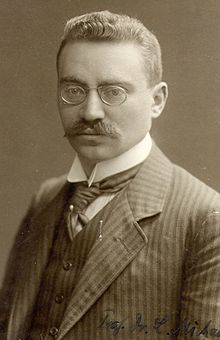Leonor Michaelis
Leonor Michaelis (born January 16, 1875 in Berlin , † October 8, 1949 in New York City ) was a German - American biochemist and physician .
Life
Leonor Michaelis was born on January 16, 1875 in Berlin as the son of the businessman Moritz Michaelis and his wife Hulda. Rosenbaum born. He graduated from the Kölln High School in Berlin. He married Hedwig born on April 11, 1905 in front of the registry office in Charlottenburg . Philipsthal. Until 1915 he was a member of the Orthodox Jewish community Adass Yisroel . Michaelis studied medicine from 1893 at the Universities of Freiburg and Berlin , where he received his doctorate in 1897 . Among his academic teachers were Emil Fischer in chemistry, Oscar Hertwig in embryology and Emil du Bois-Reymond in physiology.
After completing his studies, he was assistant to Paul Ehrlich in 1898/99 , from 1899 to 1902 to Moritz Litten (1845–1907) and from 1902 to 1906 to Ernst Victor von Leyden . From 1906 he headed the bacteriological laboratory at the Urban Urban Hospital in Berlin, in 1908 he was appointed associate professor at the University of Berlin . In 1922 he was elected a member of the Leopoldina .
In 1922 he followed a call to the "Aichi Prefectural Medical College", which later became the Medical Department of Nagoya University , to a chair in biochemistry . In 1926 he went to the Johns Hopkins University in Baltimore and finally in 1929 to the Rockefeller Institute for Medical Research in New York City. In 1943 he was elected to the National Academy of Sciences .
plant
He was primarily known for his fundamental studies on the kinetics of enzymatic reactions , which together with Maud Menten developed from 1910 Michaelis-Menten kinetics and introduced there Michaelis constant . The work was based on research by the French chemist Victor Henri . He also pioneered in the study of the influence of the pH , ie, the hydrogen ions - concentration or activity , the activity of enzymes .
Michaelis began to deal with histological staining while working for Paul Ehrlich . He developed suitable methods for staining mitochondria using the Janus green B dye . He examined the Michaelis Gutman bodies named after him for urinary tract infections .
In 1914 he published an article in which he rightly criticized Emil Abderhalden's theory of the so-called “defense ferments” , which supposedly could be used to test for pregnancy. This courageous public criticism of the then very established Abderhalden made it difficult for him to get a full professorship in Germany.
Finally, he recognized the solubility of keratin in thioglycolic acid as a fundamental principle of permanent waves .
Fonts (selection)
- Introduction to dye chemistry. Berlin 1902.
- Surface dynamics. Dresden 1909.
- Introduction to mathematics for biologists and chemists. Berlin 1912; 3rd edition 1927.
- The hydrogen ion concentration. Berlin 1914
- Physical chemistry internship. Berlin 1921
- The effects of ions in colloidal systems. Berlin 1925.
- The theoretical basis for the importance of the hydrogen concentration in the blood. In: Manual of normal and pathological physiology. Volume 6.1, Berlin 1928.
literature
- Michael Engel: Michaelis, Leonor. In: New German Biography (NDB). Volume 17, Duncker & Humblot, Berlin 1994, ISBN 3-428-00198-2 , p. 435 f. ( Digitized version ).
- Leonor Michaelis. 1875-1949 (PDF; 2.4MB). A Biographical Memoir by L. Michaelis, DA MacInnes and S. Granick J., National Academy of Sciences.
Web links
Individual evidence
- ↑ see marriage register entry of the StA Charlottenburg I No. 199/1905.
- ↑ see marriage register entry of the StA Charlottenburg I No. 199/1905.
- ↑ Albert Gossauer: Structure and reactivity of biomolecules . Wiley, Weinheim 2006, ISBN 3-906390-29-2 , p. 451.
- ↑ L. Michaelis, ML Menten: The kinetics of the invertin effect , Biochem. Z. 49, pp. 333-369, 1913.
- ↑ L. Michaelis, H. Davidsohn: The effect of hydrogen ions on the invertin , Biochem. Line 35, pp. 386-412, 1911.
- ↑ L. Michaelis, L. von Lagermarck: The Abderhaldensche pregnancy diagnosis, Dtsch. Med. Wochenschr. 7, pp. 316-319, 1914.
| personal data | |
|---|---|
| SURNAME | Michaelis, Leonor |
| BRIEF DESCRIPTION | German-American biochemist and physician |
| DATE OF BIRTH | January 16, 1875 |
| PLACE OF BIRTH | Berlin |
| DATE OF DEATH | October 8, 1949 |
| Place of death | New York City |

